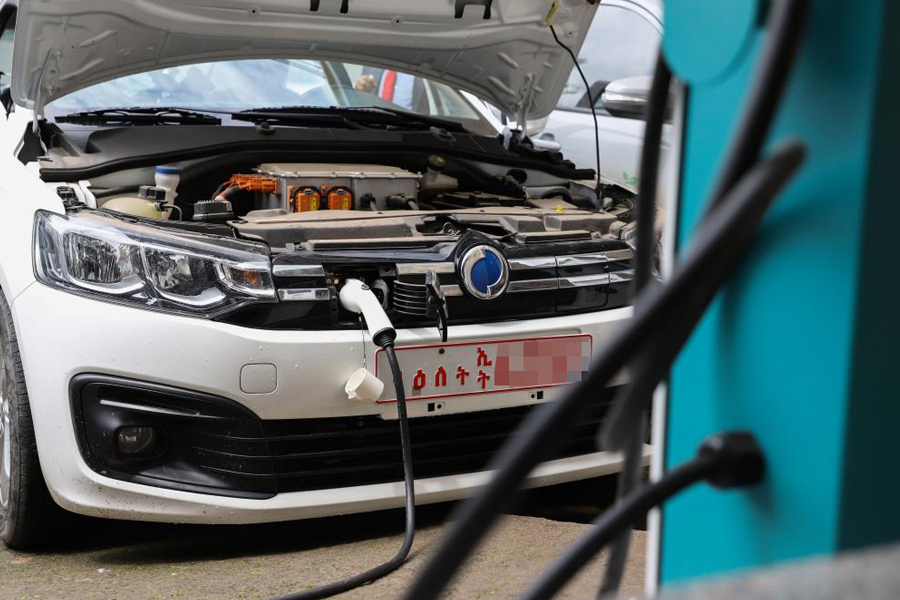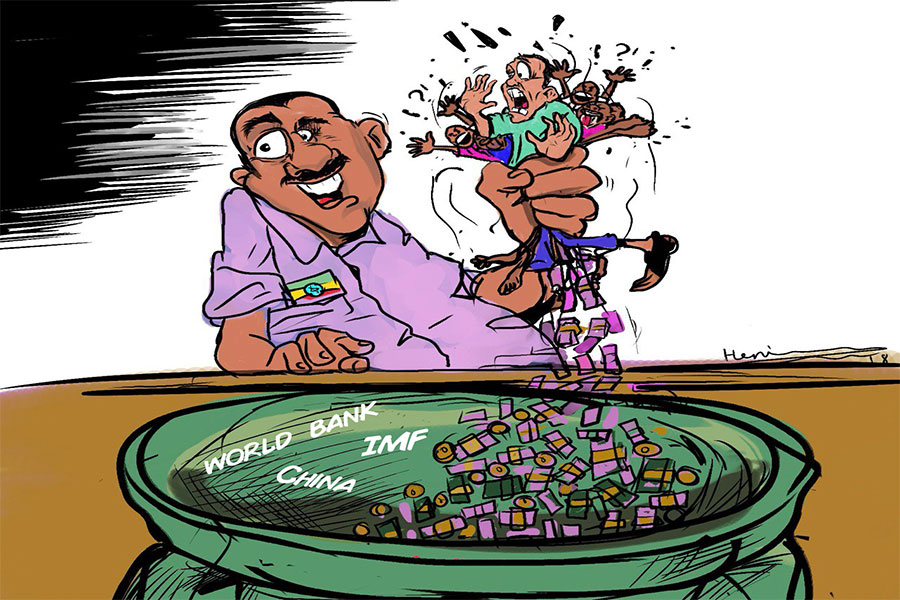Enat Bank closed its 2023/24 financial year with considerable growth in assets, deposits, and equity, yet it found its profitability under pressure as expenses climbed and took a bite out of margins.
The Bank’s balance sheet strength was evident in its total assets, which rose to 27.2 billion Br, seeing a 19.2pc growth, fueled by a solid balance sheet expansion that signalled healthy market confidence. Deposits climbed by 17.7pc to 21 billion Br, a sign that depositors maintained confidence in the Bank’s capacity to safeguard their funds. However, deposits across the private banking spectrum climbed by 30pc.
Despite improved income streams leading to revenues jumping by 28.9pc to 4.29 billion Br, these gains did not translate into robust profit growth. Pre-tax earnings slid by 1.36pc to 714 million Br, while net profit inched ahead by just 2.1pc to 555 million Br. The borderline increase in net profit coincided with a slight dip in the net profit margin, which went to 12.94pc from 13.04pc a year earlier. Rising costs, particularly operating and personnel expenses, constrained the benefits of higher income.
Administrative expenses, combined with personnel costs, accounted for a substantial slice of total expenses, with staff-related expenditures alone accounting for 28.5pc of the Bank’s outflows. Although this ratio is much lower than the industry average, the pressure on Enat Bank’s bottom line appeared more pronounced this year than in the preceding period, featuring a 73pc profit growth.
This time around, the profit after tax marked a slowdown even though it still performed better than some of its competitors. Global Bank, for instance, saw its profits dip by 10pc, while Berhan Bank soared with a 132pc profit surge. Shareholders at Enat Bank felt the brunt of these results. Earnings per share slid from 239 Br to 201 Br, equating to a 20.1pc return on shares, noticeably lower than the industry average of 31.6pc.
Enat Bank's President, Ermias Andarge (PhD), attributed the year’s modest profit growth to the confluence of a capital injection strategy and an ambitious branch expansion effort. According to him, the Central Bank's policies restricted lending, reducing the pace of loan growth and tempering interest income. Loan growth in the private sector averaged 27pc, outpacing Enat Bank’s 14.1pc.
Liquidity remained at comfortable levels, with cash and bank balances reaching 5.26 billion Br, up by 19.2pc, placing the liquidity-to-assets ratio at 19.3pc. Yet, the Bank’s loan-to-deposit ratio eased to 81.3pc from 83.8pc the previous year, showing a bit of caution in extending credit as the National Bank of Ethiopia (NBE) imposed regulatory ceilings of 14pc, which it improved by four percentage points recently.
However, interest income from loans and investments rose by 30.5pc to reach three billion Birr. Service charges and commissions gained 26.8pc to 778.79 million Br. Foreign exchange and other sources of operating income went up 22.5pc, leading to a total of 4.3 billion Br in overall income.
Ermias said export, remittance, and foreign direct investment contributed immensely to foreign exchange gains.
“We plan to expound on this,” he told Fortune.
Along with revenue, Enat Bank’s total assets climbed by 19.2pc to 27.22 billion Br, an expansion that some industry watchers find impressive against the backdrop of a tight monetary climate. As of June 2024, private banks collectively had 3.3 trillion Br in total assets, posting an annualised growth of 28pc.
“It’s evident that deposit mobilisation, forex generation, and other key metrics are in a healthy growth,” Ermias said. “We plan to continue that.”
Despite these positive signs on the revenue side, the surge in costs overshadowed the benefits.
Interest payments on savings registered a 34.3pc jump to 1.84 billion Br, surpassing the growth in income. Competition for deposits is fierce across the banking industry, and analysts observe that Enat Bank likely found itself in a position to offer more attractive rates to hold on to and attract depositors. The increase in interest expenses transpired even though deposits expanded by a more tempered 17.6pc, reaching 21 billion Br.
According to analysts, the disparity is a sign of the difficult balance Enat Bank's executives maintained between drawing in fresh capital and protecting profit margins.
The Bank opened 51 new branches this year, raising its total to 201. Interest-free banking services, offered under the Ummi brand, now operate in 190 of these branches. The expansion of physical locations is a sign of Enat’s broader strategy, but it also comes with operational costs. The expansion of the workforce added to the Bank’s cost pressures. Staff numbers rose by 24pc, totalling 1,930 employees, pushing salary and benefits up 50.4pc to over one billion Birr.
Other operating expenses expanded by 56.2pc to 634 million Br. These expenditures weigh on the Bank’s profitability and spark questions about whether Enat Bank can rein in costs moving forward. Abdulmenan Mohammed (PhD), a financial analyst based in London, cautioned that if these expenses remain unchecked, the Bank may face long-term risks to its bottom line.
The President concurred. He disclosed plans to tame the speed of branch expansion and invest more in digital services as a strategic cost-control measure.
“We plan to lower administrative costs,” he told Fortune.
Another notable item in Enat Bank’s ledger was the reduction of its loan impairment provisions by 41.3pc, down to 87.6 million Br. While this helped the Bank’s short-term earnings, observers cautioned that such a decline in reserves might leave Enat more vulnerable if the economy takes a turn for the worse or unforeseen credit defaults rise. Ermias disclosed that Enat Bank plans to reduce its non-performing loans (NPLs) in tandem with the lower provisioning level.
Ermias has been a president since December 2020 and brings extensive experience to Enat Bank. He holds academic credentials from Addis Abeba, Greenwich, and Key West universities, and was a deputy president in charge of corporate services since Enat’s founding 12 years ago. He spent 15 years in various roles at the Bank of Abyssinia (BoA). A third president since Enat Bank's incorporation, he sees digital banking as the future.
Under his stewardship, Enat Bank is integrating new technologies, forging partnerships in electronic payment gateways, and introducing solutions such as the Maleifya Digital Lending Platform, M-Pesa integration, and Arif POS services. In the past year, it processed 1.2 million digital transactions, and Ermias believes this move to digital platforms will help Enat grow.
“Everyone is a rookie in the digital realm, which levels the playing field for us,” he told Fortune.
One staff member, a branch manager turned operations officer, has witnessed Enat Bank’s move toward digitisation firsthand. Muleta Nigussie was transferred to the Netsanet Mengistu branch in Addis Abeba after managing a branch in Jimma. He sees the Bank’s pursuit of digital solutions as vital in an era when customers increasingly prefer to transact online.
“That’s the future of banking,” he said.
Enat’s board of directors, chaired by Aster Solomon, is looking toward several looming changes in the banking industry. The newly introduced floating exchange rate regime, the advent of a capital market, and the potential opening of the financial sector to foreign capital may ignite competition and innovation. However, Aster sees them as catalysts for growth. She believes these developments will support Enat Bank’s expansion, improve liquidity conditions, and help it achieve objectives like erecting a new headquarters.
Incorporated over a decade ago with 135.5 million Br in equity raised from around 8,000 shareholders, Enat Bank has carved out a mission to empower women entrepreneurs through targeted products and services. Launched by 11 women promoters, including Meaza Ashenafi, the former Supreme Court President, the Bank stands out for its focus on women financial inclusion.
“It’s our unique value,” said Ermias, arguing that this characteristic sets the Bank apart.
Enat Bank’s paid-up capital grew to three billion Birr, a growth of 18.1pc, lower almost by half of the industry's average. However, it needs an additional two billion Br to meet the regulatory minimum requirement of five billion Br by 2026.
“We’ll be focusing on capital expansion,” Ermias told Fortune. “It’s what keeps us up at night. But, we are hopeful.”
Nonetheless, Enat Bank's capital adequacy ratio (CAR) was a comfortable 21.18pc, well above the threshold set by regulators, signalling that it has sufficient loss-absorbing capacity if loan defaults rise unexpectedly. It retains adequate liquidity, with cash and bank balances making up 24.6pc of deposits, providing a crucial safety net should economic conditions deteriorate and depositors suddenly need their funds. But, Enat Bank is heavily reliant on deposits for over 90pc of its liabilities, which could become a vulnerability if market dynamics shift and deposit competition intensifies.
However, the Bank remains well-capitalised overall, with a total equity of 4.21 billion Br — up by 17.7pc — and a capital-to-asset ratio of 15.5pc.
Although it remains smaller than some of its peers, Enat Bank has a loyal customer base that believes in gender empowerment. It has partnered with international organisations such as the MasterCard Foundation to fortify its resources and widen its outreach to women.
However, founding shareholder Yohannes Meshesha sees further room for growth, particularly in the area of expanding services to women-owned businesses. Also a shareholder at Hibret Bank and acknowledged Enat Bank’s relatively modest size, Yohannes is convinced the Bank’s distinct social role will keep attracting customers. He conceded that the economic climate may be bumpy, with regulatory policies restricting lending and financial institutions competing for a limited pool of deposits. He is also convinced that Enat Bank’s management can seize opportunities if they refine their cost controls and customer acquisition strategies.
“They've to buckle up,” he told Fortune.
The Bank’s efficiency metrics painted a mixed picture. Its asset turnover rate, measuring how effectively the bank generates revenue from its assets, improved to 15.77pc from 14.61pc. But, return on equity (RoE) inched down to 13.18pc from 13.25pc, and return on assets (RoA) stayed around 2.04pc. The equity multiplier, a gauge of leverage, rose to 6.46 from 6.38, revealing the Bank is leaning a bit more toward external funding sources. Loans and advances comprised 62.7pc of total assets, leaving the door open for more proactive lending if conditions become favourable.
Enat Bank’s income composition relied heavily on net interest income, which accounted for 27.1pc of total revenue, a steady performance compared to the previous year, with interest expenses comprising 51.4pc of total costs. This ratio uncovers the ongoing struggle in the banking industry to manage costs associated with higher deposit rates amid tightening monetary policies. The Bank’s loan-loss provisioning dropped to 0.46pc of total loans from 0.94pc the year before, either representing an improved loan portfolio or a more aggressive posture with reduced safeguards for potential defaults.
PUBLISHED ON
Feb 16, 2025 [ VOL
25 , NO
1294]

Dec 22 , 2024 . By TIZITA SHEWAFERAW
Charged with transforming colossal state-owned enterprises into modern and competitiv...

Aug 18 , 2024 . By AKSAH ITALO
Although predictable Yonas Zerihun's job in the ride-hailing service is not immune to...

Jul 28 , 2024 . By TIZITA SHEWAFERAW
Unhabitual, perhaps too many, Samuel Gebreyohannes, 38, used to occasionally enjoy a couple of beers at breakfast. However, he recently swit...

Jul 13 , 2024 . By AKSAH ITALO
Investors who rely on tractors, trucks, and field vehicles for commuting, transporting commodities, and f...

Nov 1 , 2025
The National Bank of Ethiopia (NBE) issued a statement two weeks ago that appeared to...

Oct 25 , 2025
The regulatory machinery is on overdrive. In only two years, no fewer than 35 new pro...

Oct 18 , 2025
The political establishment, notably the ruling party and its top brass, has become p...

Oct 11 , 2025
Ladislas Farago, a roving Associated Press (AP) correspondent, arrived in Ethiopia in...